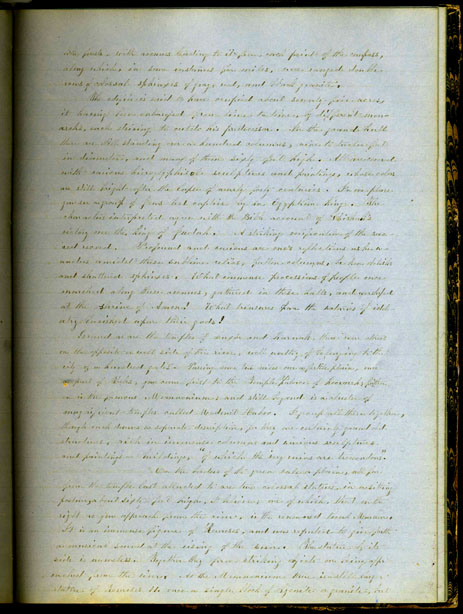Travel
Diary of Mrs. R.P. Eaton:
Europe,
Egypt, and Palestine, ca. 1857

The edifice is said to have occupied about seventy-five acres, it having been embarked from time to time, by different monarchs, each striving to outdo his predecessor. In the grand hull there are still standing over a hundred columns, nine to twelve feet in diameter, and many of them sixty feet high. All are covered with various hieroglyphical sculptures are paintings, whose colors are still bright after the lapse of nearly forty centuries. In one place you see a group of pews held captive by an Egyptian king. The characters interpreted agree with the Bible account of Shishab’s victory over the king of Judah. A striking verification of the sacred record. Profound and various are one’s reflections as he wanders amidst these sublime relics, fallen columns, broken obelisks and shattered sphinxes. What immense processions of people once marched along these avenues, gathered in these halls, and worshiped at the shrine of Amon! What treasures home the polaries of idolatry lavished upon their gods!
Grand as are the temples of Luxor and Harmak, there were others on the
opposite or west side of the river, well worthy of belonging to the city
of a hundred gates. Passing some ten miles on a fertile plain, once a
past of Thebes, you come first to the Temple Pavce or Hoormeh, farther
on is the famous memmorium; and still beyond is a cluster of
magnificent temples called Medenet Houbee. A group of all these together
though each deserves a separate description, for they are certainly grand
old and paintings – buildings “of which the very ruins are
tremendous.”
-- On the borders of the green bale or plain, not far from the temple
last alluded to are two colossal statues, in a sitting pasture, about
sixty feet high, I believe, one of which that on the right as you approach
from the river, is the renowned Pearl Memmon. It is an immense figure
of Remeses, and was saluted to give forth a musical sound at the rising
of the sun. The statue by its side is nameless. Together they form striking
objects – on being approached from the river. At the Memmorium there
is a still larger statue of Hermesis II. Once a single block of Ipenite
or granite, but